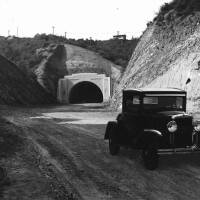How the 5 Freeway Made Orange County Suburban

If Orange County had a skeleton, the 5 freeway would be its spine. Paralleling the coast, the 44-mile superhighway bisects the county lengthwise and links it with Los Angeles to the north and San Diego to the south. Subsidiary freeways – the 91, the 22, the 55 – radiate outward toward the county’s coastal and inland communities. Shopping centers, theme parks, sports venues huddle around its off-ramps. And thanks to its skewed, northwest-southwest orientation, the freeway intersects many of the county’s arterial roads, which tend to follow the cardinal points of the compass. No other piece of infrastructure so thoroughly binds together the spatial structure of Orange County.
The 5 freeway represents the merger of two older, historic transportation corridors: the Southern Pacific Railroad's Santa Ana branch, and El Camino Real.
Built over eleven years from 1950-60 and opened in several stages, the freeway – signed as Interstate 5 and named the Santa Ana Freeway north of the El Toro Y and the San Diego Freeway south of it – represents the merger of two older, historic transportation corridors. From the Los Angeles County line to Santa Ana, it follows the former route of the Southern Pacific’s Santa Ana branch. South from Santa Ana to the San Diego County line, it traces the path of El Camino Real, the mythic Spanish-era highway that became US-101 in 1926. Repurposing existing rights-of-way meant that, relative to other Southern California freeway projects, construction displaced few people. It also helped that, for much of its length, construction crews paved over orange groves, bean fields, and cattle pastures rather than residential neighborhoods; when construction began, Orange County was a decidedly rural place, an agricultural landscape dotted by a few small towns, distinct from the Los Angeles metropolis.
It wouldn’t remain so for long. Even before it opened, the 5 freeway lured major aerospace firms like Douglas, Lockheed, and Hughes across the so-called Orange Curtain. When Walt Disney commissioned the Stanford Research Institute to recommend a location for his Magic Kingdom, the consultants suggested Anaheim in part because of the easy access the Santa Ana Freeway would provide. With jobs at Douglas, Lockheed, Hughes, and Disney came new residents, as well as new subdivisions to house them – first on the plains of North County, where Los Angeles’s suburban growth sprawled across the county line, and then on the hilly pastures of South County, where leafy, master-planned communities sprang from the grazing lands and truck farms of the Irvine Ranch and Rancho Mission Viejo. Its backbone in place, Orange County soon evolved from its rural, embryonic form (1950 population: 216,224) into the fully realized postmodern metropolis (2010 population: 3,010,232) we know today.











